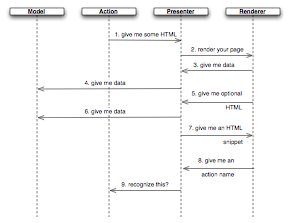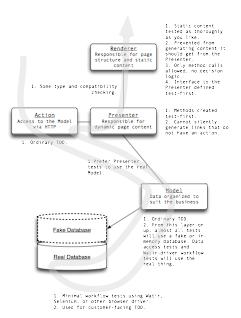Sat, 18 Feb 2006
Model-Renderer-Presenter: MVP for web apps?
 A client and I were talking over how Model-View-Presenter would work
for web applications. The sequence diagram to the right (click on it
to get a bigger version in a new window) describes a possible
interpretation. Since the part that corresponds to a View just converts
values into HTML text, I'm going to
call it the Renderer instead. The Renderer can be either a template language
(Velocity, Plone's ZPT, Sails's Viento)
or—my bias—an XML builder
like Ruby's Builder.
A client and I were talking over how Model-View-Presenter would work
for web applications. The sequence diagram to the right (click on it
to get a bigger version in a new window) describes a possible
interpretation. Since the part that corresponds to a View just converts
values into HTML text, I'm going to
call it the Renderer instead. The Renderer can be either a template language
(Velocity, Plone's ZPT, Sails's Viento)
or—my bias—an XML builder
like Ruby's Builder.
I did a little Model-Renderer-Presenter spike this week and feel
pretty happy with it. I'm wondering who else uses something like
what I explain below and what
implications it's had for
testing. Mail me if you
have pointers.
(Prior work: Mike Mason just wrote
about MVP on ASP.NET. I
understand from Adam Williams
that Rails does something
similar, albeit using mixins. So far handling
the Rails
book hasn't caused me to learn
it. I may actually have to work through it.)
Here's the communication pattern from the sequence diagram:
After the Action gets some HTTP and does whatever it does to the
Model, it creates the appropriate Presenter (there is one for each
page) and asks it for the HTML for the page.
The Presenter asks the Renderer for the HTML for the page. The Renderer is the
authority for the structure of the page and for any static content
(the title, etc.) The Presenter is the authority for any content that
depends on the state of the Model.
When the Renderer needs to "fill in a blank", it asks the Presenter. In
this case, suppose it's asking for a quantity (like a billing amount).
The Presenter gets that information from the Model.
The Renderer can also ask the Presenter to make a decision. In this case,
suppose it asks the Presenter whether it should display an edit
button. I decided that the Presenter should either give it back an
empty string or the HTML for the button. That works as follows:
First, the Presenter asks the Model for any data it needs to make the
decision. Suppose that it decides the button should be displayed. But
it's not an authority over what HTML should look like, so it...
... asks the Renderer for that button's HTML. As part of rendering that
button, the Renderer needs to fill in the name of the Action the button
should invoke. It could just fill in a constant value, but I want the
program to check—at the time the page is displayed—whether that
constant value actually corresponds to a real action. That way, any
bad links will be detected whenever the page is rendered, not when the
link is followed. Since there are unit tests that render each page,
there will be no need for slow browser or HTTP tests to find bad
links. Therefore...
... the Renderer asks the Presenter for the name to fill in.
The Presenter is the dispenser of Action names. Before giving the
name to the Renderer the Presenter asks the Action (layer) whether the
name is valid. The Action will blow up if not. (It would make as much
sense—maybe more—to have the Action be the authority over
its name but
this happened to be most convenient for the program I started the
spike with.)
What good is this? Classical Model-View-Presenter is about making the
View a thin holder of whatever controls the windowing system
provides. It does little besides route messages from the window
system to the Presenter and vice versa. That lets you mock out the
View so that Presenter tests don't have to interact with the real
controls, which are usually a pain.
 There's no call for that in a web app. The Renderer doesn't interact
with a windowing framework; it just builds HTML, which is easy to work
with. However, the separation does give us four objects (Action, Model,
Renderer, and Presenter) that:
There's no call for that in a web app. The Renderer doesn't interact
with a windowing framework; it just builds HTML, which is easy to work
with. However, the separation does give us four objects (Action, Model,
Renderer, and Presenter) that:
can be created through test-driven design,
can be tested independently of each other,
and can be tested in a way that doesn't require many end-to-end tests
to give confidence that almost all of the plausible bugs have been
avoided.
The second picture gives a hint of the kinds of checks and tests
that make sense here. (Click for the larger version. Safari users note
that sometimes the JPG renders as garbage for me. A Shift-Reload has
always fixed it.)
More later, unless I find that someone else has already described
this in detail.
## Posted at 10:31 in category /testing
[permalink]
[top]
|

